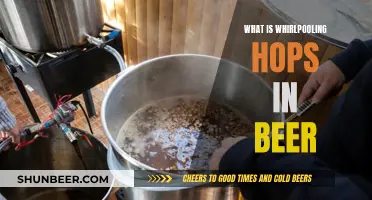
Beer is traditionally made with four ingredients: malt, yeast, hops, and water. Hops are added to the wort when it enters the boiling stage of the brewing process. The high temperatures cause the release of isohumulone, which adds a bitter flavour to the hot wort. Hops are one of the main sources of bitterness in beer, and they help to balance the sweetness derived from the malt. However, hops can also add a range of other flavour characteristics, including fruity, floral, woody, spicy, and earthy notes.
| Characteristics | Values |
|---|---|
| Hops' role in beer | Add bitterness, balance, aroma, flavour, act as a preservative |
| Hoppy vs bitter | Hoppy refers to the flavour and aroma of hops; bitter refers to the level of bitterness |
| Bitterness | One of four individual tastes sensed by different areas of the human tongue |
| Alpha acids | The main source of bitterness from hops |
| Iso-alpha acids | Produced from alpha acids during the wort boil; the main source of bitterness in beer |
| Relative bitterness | Depends on the malt used, the ABV and the amount of hops |
| Perceived bitterness | Depends on the individual's ability to taste and handle bitterness |
| International Bitterness Units (IBUs) | The scale used to measure the bitterness of a beer |
What You'll Learn
- Hops are added during the boiling stage of the brewing process to release isohumulone, which adds bitterness
- Hops contain alpha acids that are broken down by the boil to produce isohumulone
- The type of hop, amount used, and how it is used will determine the level of bitterness
- Hops are divided into bittering and aroma varieties
- Aroma hops are added later in the brewing process to preserve aromatic oils

Hops are added during the boiling stage of the brewing process to release isohumulone, which adds bitterness
Hops are added to beer during the boiling stage of the brewing process. This is done to release isohumulone, which adds bitterness to the beer. Hops are the flowers or cones of the plant humulus lupulus. They have preservative qualities, keeping beer fresh for longer, and help the beverage retain its head of foam, a key component of its aroma and flavour. Hops also add bitterness, aroma, flavour, and act as a preservative.
The timing of hop additions is critical. Adding hops early in the brewing process contributes more bitterness to the beer, whereas adding hops later in the process adds more to the aroma. Hops are divided into two general varieties: bittering hops and aroma hops. Bittering hops have higher levels of alpha acids, which are the main source of bitterness in beer. A small amount of bittering hops goes a long way. Aroma hops, on the other hand, tend to have more essential oils, which contribute to the "'hoppiness' of the beer, including aromas like citrus, pine, mango, and resin.
The amount of hops added to the beer also plays a role in the bitterness of the final product. Even with early additions of hops, it is possible to end up with an un-bitter beer if the amount of hops added is small.
The International Bitterness Unit (IBU) is used to measure the bitterness of a beer. Beers with an IBU of over 80 are considered to be on the higher end of the bitterness scale. However, the perceived bitterness of a beer also depends on other factors, such as the relative amount of malts and alcohol content.
Zywicki Portor Beer: Hops or No Hops?
You may want to see also

Hops contain alpha acids that are broken down by the boil to produce isohumulone
Hops are flowers or cones from the humulus lupulus plant. They are one of the four basic ingredients of beer and are essential in preventing it from becoming overly sweet. Hops are also a preservative, helping to keep beer fresh for longer.
Hops contain alpha acids, which are found in the resin glands of the hop flowers. When hops are added to the boiling wort (unfermented beer), the alpha acids are extracted from the lupulin glands. The application of heat in solution causes isomerization, where the alpha acids are converted into iso-alpha acids, the most common of which are isohumulones. The longer the hops are boiled, the more alpha acids are isomerized, and the more bitter the beer becomes.
The degree of bitterness produced depends on the type of hops used, the amount used, and the length of boiling time. Hops with higher alpha acid content will contribute more bitterness. The alpha acid "rating" on hops indicates the amount of alpha acid as a percentage of the total weight of the hop.
The bitterness of beer is measured using the International Bitterness Units (IBUs) scale, which measures the isohumulone present. Beers with an IBU rating of over 80 are considered high on the bitterness scale. However, a beer with a high IBU rating may not necessarily taste bitter due to other factors such as the amount of malts used.
Dry Hopping Beer: Contamination Risk or Myth?
You may want to see also

The type of hop, amount used, and how it is used will determine the level of bitterness
The type of hop, the amount used, and how it is used will all influence the bitterness of a beer.
Type of Hop
The variety of hop used will affect the bitterness of a beer. This is because the relative amount of alpha acids in a hop will differ depending on the variety. Alpha acids are the main source of bitterness from hops, and iso-alpha acids, produced from alpha acids during the wort boil, are the main source of bitterness in beer. The three main alpha acids are humulone, cohumulone, and adhumulone. The relative amount of these homologous alpha acids varies according to the variety of hop. For example, aroma hops are usually lower in cohumulone than less desirable hops, and iso-cohumulone in beer has a harsher, more lingering bitterness than the other iso-homologs.
Amount Used
The amount of hops used will also influence the bitterness of a beer. Hops are dosed into the brew kettle based on their alpha-acid content, and brewers will seek to hit a target bitterness level. The bitterness in beer is measured by the International Bitterness Unit (IBU), which measures the isohumulone in a beer. However, the relationship between measured IBUs and perceived bitterness is not always clear. A beer with a high IBU will not necessarily taste bitter, as the malts used in beer can balance out the bitterness. For example, a beer with 60 IBUs and a 6% ABV will taste about as bitter as a 90 IBU beer with a 9% ABV.
How It Is Used
The way in which hops are used will also affect the bitterness of a beer. Brewers are increasingly adding large quantities of hops late in the brewing process, particularly post-boil, to maximise the impact of the aroma. This changes the matrix of bittering compounds in ways that have not been widely investigated. Additionally, when hops are added during or after fermentation, hop oil is dissolved directly into the beer, resulting in a strong aroma of hops and often an "oil burn", which increases the perceived bitterness.
Grow Your Own Hops for Beer: A Step-by-Step Guide
You may want to see also

Hops are divided into bittering and aroma varieties
Hops are divided into three categories: aroma hops, bittering hops, and dual-purpose hops.
Aroma hops, also known as finishing hops, are added to the beer for their flavouring. They are added towards the end of the boil, during the last 10-15 minutes, or during the whirlpool stage. They are low in alpha acids and have a 1:1 ratio of alpha:beta acid content. This makes it difficult to add bitterness to the beer with aroma hops, although it is not impossible. Aroma hops are used in dry hopping, where they are added to the fermenter after the yeast has been added.
Bittering hops, also known as kettle hops, are added at the start of the boil and are boiled for about an hour. They have a high alpha acid content, which makes them more bitter. The longer boiling time breaks down the acids so that the wort can absorb them, a process known as isomerization.
Dual-purpose hops have high amounts of both alpha acids and essential oils. They can be added at any stage of the brewing process.
Hop Boiling in Beer: Necessary or Not?
You may want to see also

Aroma hops are added later in the brewing process to preserve aromatic oils
Hops are one of the four basic ingredients of beer and are essential in providing balance to the beverage. They add bitterness to counter the sweetness of the malt, and they also act as a preservative, helping beer to retain its head of foam and keeping it fresh for longer. Hops also have a lot more to offer in terms of aroma, flavour, and texture.
The timing of hop additions during the brewing process is crucial as it impacts the aroma, flavour, and bitterness of the beer. Hops are typically added in three stages: bittering, flavouring, and aroma. While bittering hops are added early in the process to extract maximum bitterness, flavouring and aroma hops are added later to impart unique flavours and delicate aromas without excessive bitterness.
Aroma hops, in particular, are added during the later stages of the brewing process, usually during the last 5 to 20 minutes of the boil, or during whirlpooling or dry hopping. This timing ensures that the volatile hop oils responsible for the aroma are not driven off in the steam of the boil. By adding aroma hops later, brewers can maximise the aroma contribution while minimising the extraction of bitter alpha acids.
Aroma hops are specifically cultivated for their aromatic qualities and are rich in essential oils. They impart distinct flavours and fragrances to the beer, such as floral, fruity, citrus, or spicy notes, without contributing significantly to bitterness. The use of aroma hops is vital in crafting a beer's sensory profile, especially for styles like IPAs, pale ales, and pilsners, where a strong emphasis is placed on hop-forward flavours and aromas.
Guinness Beer's Hoppy Secret: A Complex Blend
You may want to see also
Frequently asked questions
Hops are flowers, or cones, of the plant humulus lupulus. They are one of the four basic ingredients of beer.
Hops contain alpha acids, which break down to produce isohumulone—a compound that adds bitterness to beer. The level of bitterness depends on the type of hop, the amount used, and how it is used.
Bittering hops have higher levels of alpha acids, making them more economical for adding bitterness to beer. Aroma hops, on the other hand, tend to have more essential oils that contribute to the "hoppy" aroma and flavour.
Yes, not all beers are bitter. Some beer styles with low bitterness include Witbier, Hefeweizen, Oktoberfest/Marzen, Milk Stout, and Saison.







